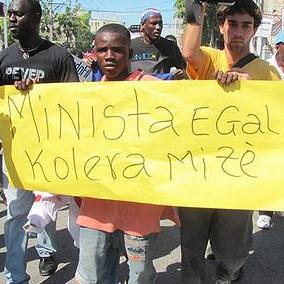 聯合國及其合作夥伴已經確定了1.64億美元的援助海地政府處理霍亂疫情的計劃。根據聯合國的報告,到目前為止,已有超過1萬2千海地人住院,超過800人死亡。
聯合國及其合作夥伴已經確定了1.64億美元的援助海地政府處理霍亂疫情的計劃。根據聯合國的報告,到目前為止,已有超過1萬2千海地人住院,超過800人死亡。
此項海地霍亂跨部門應對策略(Cholera Inter-Sector Response Strategy for Haiti),包括了42個非政府組織、5個聯合國機構、國際移民組織,以支持處理應變的海地公眾健康和人口部(Ministry of Public Health and Population)。
這是海地50年來首次霍亂大流行。10月22日位於首都太子港北部的阿蒂博尼特省(Artibonite province)首次證實霍亂病例,現在已迅速蔓延。
9日,海地健康部說,擁有300萬人口的太子港已有73個病例。今年1月海地大地震之後,130萬災民被安置在散佈於1300個地點的臨時帳篷。
 Ezra Barzilay是美國疾管局流行病學專家。他11日在海地透過電話跟正在密西西比州比洛克西(Biloxi, Mississippi)開醫學會議的的同事說,美國衛生官員擔心,霍亂可能會從海地蔓延到美國,這兩地只需兩小時航程。
Ezra Barzilay是美國疾管局流行病學專家。他11日在海地透過電話跟正在密西西比州比洛克西(Biloxi, Mississippi)開醫學會議的的同事說,美國衛生官員擔心,霍亂可能會從海地蔓延到美國,這兩地只需兩小時航程。
Barzilay正在海地建立一個全國性的數據庫,這將有助於海地衛生官員追踪霍亂病例。
美國佛州衛生部門在11月2日對醫師發出通知,說:「在海地持續的霍亂疫情,可能會擴散到佛州。」
該部門說:「自從海地大地震之後,來往海地的旅客增加了,這包括回到海地探親,以及來往海地和佛州的救援人員。於是,可以預測到,有些旅客在由海地回到佛州的途中、或是才抵達不久,便出現霍亂症狀。」
 如果海地的霍亂疫情跟上次在美州爆發的模式一樣,它將會在未來數年產生數萬個病例,世界衛生組織,泛美衛生組織(Pan American Health Organization)副主任安德魯斯(Dr. Jon Andrus)說。
如果海地的霍亂疫情跟上次在美州爆發的模式一樣,它將會在未來數年產生數萬個病例,世界衛生組織,泛美衛生組織(Pan American Health Organization)副主任安德魯斯(Dr. Jon Andrus)說。
1991年從祕魯爆發的西半球霍亂疫情,從阿根廷到加拿大,蔓延到其他16個國家。衛生部門表示,從 1991年到1997年佛州出現25個病例。僅在秘魯,6年期間就有超過65萬個病例。
安德魯斯博士表示,類似模式將可導致海地出現27萬以上病例。
雖然11月5日襲擊海地的颶風托馬斯並不是多數人害怕的強烈颶風,只是一級暴風,但是暴風雨仍造成洪水氾濫,而霍亂是由水傳染(waterborne disease)的疾病,因此也增加了霍亂肆虐的風險。
「雖然托馬斯颶風的影響並不像許多人所擔心的那麼立即和嚴重,但我們有足夠理由相信,氾濫的洪水會增加霍亂傳播的風險。」安德勒斯9日表示。
洪水後傳播霍亂的情況可能在未來幾天變得很顯著,但安德魯斯說,霍亂疫情可能會持續許多年。「我們必須思考並做長遠計畫,霍亂菌在河裡和供水系統中都有立足點,因此,它可以在那兒存活好幾年。」
即使在1月地震前,太子港就沒有足夠的乾淨飲水和基礎衛生設施,再加上許多區域擁擠的生活條件等等,這些都是非常容易造成傳染霍亂的條件,安德魯斯說。
這個星期,海地衛生當局宣布此波霍亂疫情是「國家安全問題。」
 由於霍亂在海地到處擴散,示威者10日在太子港遊行,譴責派駐在海地的聯合國維和部隊--聯合國駐海地穩定特派團(MINUSTAH)。
由於霍亂在海地到處擴散,示威者10日在太子港遊行,譴責派駐在海地的聯合國維和部隊--聯合國駐海地穩定特派團(MINUSTAH)。
根據另類媒體(alternative media project)蓋伊(Bri Kouri Nouvel Gaye)的報導,MINUSTAH的尼泊爾營隊被發現,該營隊允許廁所穢物排進海地中央高原的河川裡。雖然沒有確切證據證明海地的霍亂菌來自這些士兵,尼泊爾營隊在尼泊爾本國才剛爆發霍亂疫情後幾周就開拔到海地,而海地的霍亂菌株已經確定是來自南亞。除非有確定的事證可以取代上述的臆測,否則海地人民的沮喪和憤怒繼續增長。
 此次聯合國的應對新策略小組預期有20萬人出現霍亂的症狀,從輕度腹瀉到嚴重脫水。這個數字是根據其他國家的經驗,並由泛美衛生組織( Pan-American Health Organization) /世界衛生組織(WHO)和美國疾病控制中心(CDC)計算出來的。流行病學專家預期,疫情將繼續在全國各地蔓延,而且至少還要準備6個月的資源以應付疫情。
此次聯合國的應對新策略小組預期有20萬人出現霍亂的症狀,從輕度腹瀉到嚴重脫水。這個數字是根據其他國家的經驗,並由泛美衛生組織( Pan-American Health Organization) /世界衛生組織(WHO)和美國疾病控制中心(CDC)計算出來的。流行病學專家預期,疫情將繼續在全國各地蔓延,而且至少還要準備6個月的資源以應付疫情。
聯合國的應對新策略措施包括,公共交流醫療推廣服務、快速反應行動、提供醫療衛生服務、疾病監測、支持和加強國家反應能力、確保乾淨水質,並提供高危險區域安全衛生和廢物管理。
此策略最大的資金分配是8900萬美元用於水、環境衛生和衛生設備,其次是4300萬美元的保健服務,和1900萬美元的營地協調和營地管理。
The United Nations and its partners have finalized a $164 million plan to support the government of Haiti's response to the current cholera epidemic. To date, more than 12,000 Haitians have been hospitalized, and over 800 people have died, the UN reports.
The Cholera Inter-Sector Response Strategy for Haiti includes projects from 42 nongovernmental organizations, five United Nations agencies, and the International Organization for Migration, in support of the Ministry of Public Health and Population, which is leading the response.
The cholera epidemic is Haiti's first in 50 years. First confirmed on October 22 in Artibonite province, north of the capital Port-au-Prince, it has spread rapidly.
On Tuesday, Haiti's Ministry of Health said 73 cases had been reported in Port-au-Prince, a city of three million people. Displaced by the January earthquake,1.3 million people live in makeshift camps spread across 1,300 sites.
Ezra Barzilay, an epidemiologist with the U.S. Centres for Disease Control and Prevention, told colleagues at a medical conference in Biloxi, Mississippi by phone from Haiti Thursday that U.S. health officials worry cholera could spread from Haiti to the United States, which is only two hours away by plane.
Barzilay is working in Haiti to set up a nationwide database that will help Haitian health officials to track cholera cases.
The Florida Department of Health issued a warning to doctors on November 2, saying, "An ongoing epidemic of cholera in Haiti may result in introduction of cholera cases to Florida."
The department said, "Travel to and from Haiti has increased since the Haitian earthquake; this includes local Haitian residents visiting family in Haiti and relief workers who travel to and from Haiti via Florida. As a result, we can expect that some travelers returning from Haiti may become symptomatic with cholera en route to, or shortly after arrival in Florida."
If Haiti's cholera epidemic follows a pattern similar to the last cholera epidemic in the Americas, it could produce tens of thousands of additional cases over the next several years, said Dr. Jon Andrus, deputy director of the Pan American Health Organization, a regional division of the World Health Organization.
The last cholera epidemic in the Western Hemisphere began in Peru in 1991 and spread to 16 other countries, from Argentina to north to Canada. Florida had 25 cases from 1991 through 1997, said the Department of Health.
In Peru alone, the epidemic produced more than 650,000 cases over six years.
Dr. Andrus said a similar pattern would produce upwards of 270,000 cases in Haiti.
While Hurricane Tomas just nicked Haiti as a Category 1 storm on November 5 instead of striking the island country a solid blow as many had feared, the storm still caused major flooding, and that has increased the risk of cholera, which is a waterborne disease.
"While the impact of Hurricane Tomas was not as immediate or severe as many had feared, Dr. Andrus said on Tuesday. "We have every reason to expect that the widespread flooding has increased the risk of cholera spreading."
The effects of this could become apparent through a spike in cases in the coming days but Dr. Andrus warns that this cholera epidemic could last for years.
"We have to think about and plan for the long term," he said. "The bacteria have a foothold in the rivers and the water system, so it will be there for a number of years."
Even before the earthquake last January, Port-au-Prince had inadequate water and sanitation infrastructure and crowded living conditions in many areas. Now, says Dr. Andrus, conditions in the city are "very ripe for rapid spread of cholera."
This week, Haitian health authorities declared the epidemic "a national security problem."
As cholera spreads through Haiti, protestors marched in Port-au-Prince Wednesday to denounce the UN peacekeeping mission in Haiti, MINUSTAH.
It has been discovered that the Nepalese battalion of MINUSTAH allowed their latrines to overflow into a river in Haiti's Central Plateau. Although no tests have proven definitively that the cholera in Haiti came from these soldiers, the Nepalese arrived in October, only weeks after an outbreak in Nepal, and the strain of cholera in Haiti has been defined as coming from South Asia, according to alternative media project Bri Kouri Nouvel Gaye.
Until speculation is replaced with confirmed facts, the frustration and anger among the population grows.
The UN's new strategy anticipates that up to 200,000 people will show symptoms of cholera ranging from cases of mild diarrhea to the most severe dehydration. This number was calculated based on other countries' experiences, and calculations by the Pan-American Health Organization/World Health Organization and the United States Centers for Disease Control.
Epidemiologists anticipate that the disease will continue to spread throughout the country and resources will need to be mobilized for at least six months.
The new strategy includes public communications outreach, rapid operational response, access to health services for those affected, disease surveillance, supporting and strengthening the national response, ensuring clean water, and providing safe sanitation and waste management for high risk areas.
The largest financial component of the strategy is $89 million for water, sanitation and hygiene, followed by $43 million for health services and $19 million for camp coordination and camp management.
全文及圖片詳見:ENS報導


